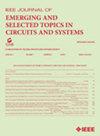采用元键合的先进快速成型方法,从2D穿梭芯片到3d集成电路的TSV模级转换
IF 3.8
2区 工程技术
Q2 ENGINEERING, ELECTRICAL & ELECTRONIC
IEEE Journal on Emerging and Selected Topics in Circuits and Systems
Pub Date : 2025-03-20
DOI:10.1109/JETCAS.2025.3572003
引用次数: 0
摘要
3D- ic技术,更合适的说法是TSV (Through-Si Via)形成技术,已经逐年成熟,并越来越多地应用于先进的半导体器件,如3D CIS (CMOS图像传感器)、HBM(高带宽存储器)和SRAM-on-CPU(称为3D V-Cache)器件。然而,最初的开发成本仍然过高,这主要是由于在晶圆一级形成TSV所需的大量投资。与此同时,传统的片上系统(soc)正在使用最新的超3nm技术节点,结合极紫外(EUV)和其他尖端技术,从Fin-FET过渡到GAA (Gate All Around)。与此同时,学术界正在建立一个有利于利用从传统的180纳米到7纳米节点的环境,使设计人员能够以更低的成本获得具有新颖架构的2D IC芯片。尽管取得了这些进步,但采用TSV的代工厂穿梭服务仍然几乎不可能利用,并且使用3d - ic进行原理验证和功能验证仍然极具挑战性。本文介绍了利用多项目晶圆(mpw)的穿梭芯片从小规模到大规模将2d - ic转换为3d - ic的最新技术进展。本文主要讨论了多芯片细化和TSV/微凸点形成的关键基本技术对模级短tat(周转时间)3d集成电路制造的促进作用。此外,Meta键合的有效性,如细间距微碰撞和直接/混合键合,描述了未来高性能3D-IC原型的有效性。本文章由计算机程序翻译,如有差异,请以英文原文为准。
Die-Level Transformation From 2D Shuttle Chips to 3D-IC With TSV for Advanced Rapid Prototyping Methodology With Meta Bonding
3D-IC technology, it may be more appropriate to refer to this as TSV (Through-Si Via) formation technology, has been maturing year by year and is increasingly utilized in advanced semiconductor devices, such as 3D CIS (CMOS Image Sensor), HBM (High-Bandwidth Memory), and SRAM-on-CPU (named 3D V-Cache) devices. However, the initial development costs remain prohibitively high, largely due to the substantial investment required for TSV formation at the wafer level. Meanwhile, conventional System on a Chips (SoCs) are transitioning from Fin-FET to GAA (Gate All Around) using the latest beyond 3-nm technology nodes, incorporating extreme ultraviolet (EUV) and other cutting-edge techniques. Meanwhile, the academic community is establishing an environment conducive to the utilization of nodes ranging from legacy 180 nm to 7 nm, making it feasible for designers to obtain 2D IC chips with their novel architectures at a reduced cost. Despite these advancements, foundry shuttle services employing TSV are still almost impossible to utilize, and performing proof of principle and functional verification using 3D-ICs remains extremely challenging. This article introduces recent advancements in technology that can transform 2D-ICs into 3D-ICs using shuttle chips for Multi-Project Wafers (MPWs) at a small scale to a large scale. This article mainly focuses on discussing the facilitation of die-level short-TAT (turnaround time) 3D-IC fabrication with key elemental technologies of multi-chip thinning and TSV/microbump formation. In addition, the effectiveness of Meta Bonding, such as fine-pitch microbump and direct/hybrid bonding, is described for future high-performance 3D-IC prototyping.
求助全文
通过发布文献求助,成功后即可免费获取论文全文。
去求助
来源期刊

IEEE Journal on Emerging and Selected Topics in Circuits and Systems
ENGINEERING, ELECTRICAL & ELECTRONIC-
CiteScore
8.50
自引率
2.20%
发文量
86
期刊介绍:
The IEEE Journal on Emerging and Selected Topics in Circuits and Systems is published quarterly and solicits, with particular emphasis on emerging areas, special issues on topics that cover the entire scope of the IEEE Circuits and Systems (CAS) Society, namely the theory, analysis, design, tools, and implementation of circuits and systems, spanning their theoretical foundations, applications, and architectures for signal and information processing.
 求助内容:
求助内容: 应助结果提醒方式:
应助结果提醒方式:


